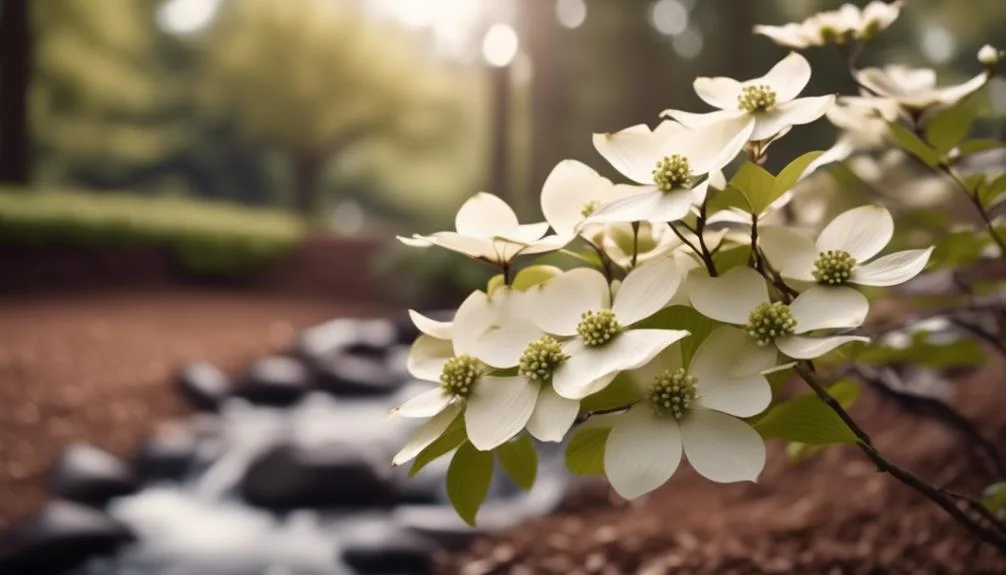Struggling to make your dogwood trees bloom? With the right care, you can encourage these stunning trees to burst into a display of flowers.
From choosing the right spot to understanding the soil, there are factors to consider.
Following these tips can make your dogwood trees a focal point in your garden, creating a beautiful sight for you and your neighbors.
Selecting the Right Location for Planting
To ensure the successful blooming of dogwood trees, it's crucial to carefully select a location that provides the ideal conditions for their growth and development. Dogwood trees thrive in locations with well-drained, slightly acidic soil, ideally with a pH level between 5.5 and 6.5. When selecting a spot, consider the amount of sunlight the area receives.
Dogwoods prefer partial shade, especially in the afternoon, to protect them from the harsh midday sun. Look for a location with dappled sunlight or filtered shade to create the perfect environment for these beautiful trees to flourish. Additionally, consider the impact of surrounding trees or structures that may obstruct sunlight or alter soil acidity.
Providing Proper Soil Conditions
Selecting the right location for planting your dogwood trees is just the beginning – ensuring proper soil conditions is essential for their successful growth and beautiful blooming.
To provide the best soil environment for your dogwood trees, consider the following:
- Soil pH: Dogwood trees prefer slightly acidic soil with a pH range of 5.5 to 6.5. Test the soil pH and amend it if necessary to create the ideal acidic environment for your trees.
- Organic Matter: Incorporate organic matter such as compost or well-rotted manure into the soil. This improves soil structure, provides essential nutrients, and encourages beneficial microorganisms.
- Drainage: Ensure the soil has good drainage to prevent waterlogging, which can lead to root rot.
- Mulching: Apply a layer of mulch around the base of the tree to retain moisture and regulate soil temperature.
- Regular Testing: Periodically test the soil to monitor its pH and nutrient levels, making adjustments as needed to maintain optimal conditions for your dogwood trees.
Pruning Techniques for Better Blooms
When aiming to enhance the blooming of your dogwood trees, employing proper pruning techniques is crucial for promoting healthy growth and abundant, vibrant blossoms. Regular pruning encourages growth by removing dead or crowded branches, allowing more sunlight and air to reach the inner parts of the tree.
Start by removing any damaged, diseased, or crossing branches. This not only improves the overall health of the tree but also maximizes sunlight exposure to the remaining branches, stimulating better blooming. Additionally, thinning out the canopy by selectively removing some branches can help ensure that sunlight reaches all parts of the tree.
Be mindful not to over-prune, as dogwood trees are sensitive to excessive cutting. Proper pruning will encourage new growth and ultimately lead to a more beautiful and floriferous dogwood tree.
Fertilizing and Watering Guidelines
Wondering how to properly fertilize and water your dogwood trees for optimal blooming? Here are some tips to help you encourage your dogwood trees to bloom:
- Fertilize in early spring with a balanced, slow-release fertilizer.
- Avoid fertilizers high in nitrogen as they can promote leafy growth at the expense of flowers.
- Water your dogwood trees deeply and consistently, especially during dry periods.
- Mulch around the base of the tree to help retain moisture and regulate soil temperature.
- Consider using a soaker hose or drip irrigation system to ensure even watering.
Dealing With Common Pests and Diseases
To maintain the health and vitality of your dogwood trees, it's essential to be vigilant in identifying and addressing common pests and diseases that can potentially affect them. Preventing pests and effectively managing diseases are key aspects of caring for your beloved dogwood trees. Here are some practical tips to help you keep your trees healthy:
| Pest Prevention | Disease Management |
|---|---|
| – Regularly inspect the leaves and stems for signs of pests. | – Prune out infected branches to prevent the spread of diseases. |
| – Use horticultural oils or insecticidal soaps to control aphids and scales. | – Apply fungicides during the tree's dormant season to prevent diseases. |
| – Encourage natural predators like ladybugs to control aphid populations. | – Ensure proper air circulation around the tree to prevent fungal diseases. |
| – Keep the area around the tree free of debris to discourage pests. | – Avoid overhead watering to prevent leaf spot and powdery mildew. |
| – Maintain overall tree health through proper watering and fertilization. | – Plant dogwood trees in well-drained soil to prevent root rot. |
Conclusion
With these techniques, your garden can become a vibrant display of dogwood blossoms.
By tending to location, soil, pruning, fertilizing, and watering, you ensure thriving and abundant blooms.
Care and attention yield stunning outdoor beauty.

My interest in trees started when I first saw the giant sequoias in Yosemite.
I was a teenager then, and I remember thinking, “I need to learn more about this.”
That moment stuck with me.
A few years later, I went on to study forestry at Michigan Tech.
Since graduating, I’ve worked in a mix of hands-on tree care and community education.
I’ve spent over ten years helping people understand how to plant, maintain, and protect the trees in their neighborhoods.
I don’t see trees as just part of the landscape.
They are living things that make a real difference in our daily lives.
